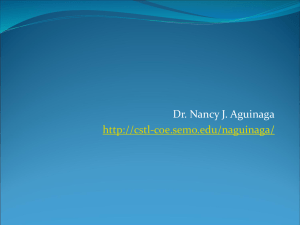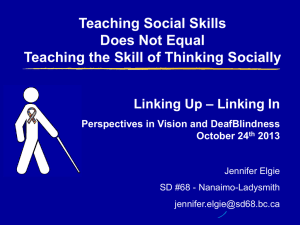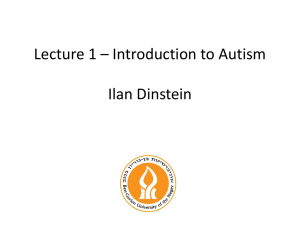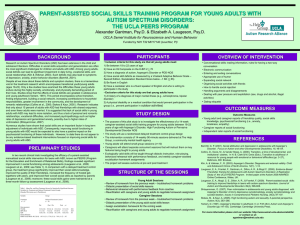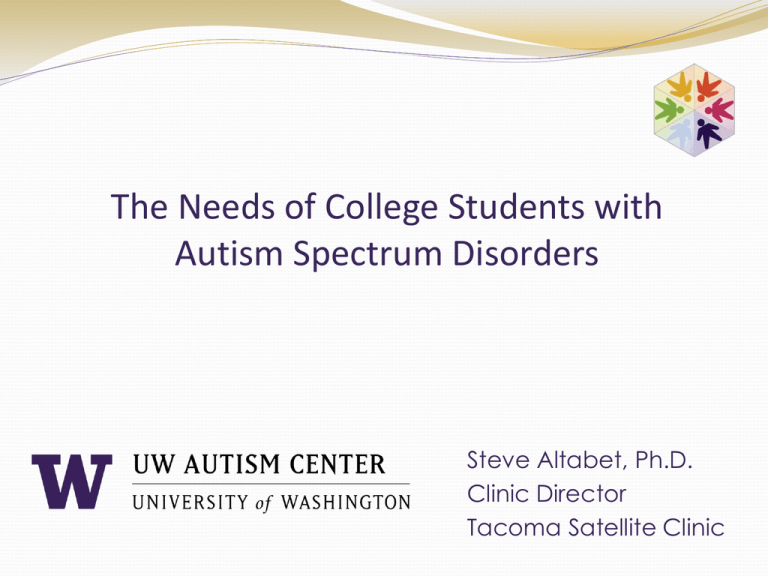
The Needs of College Students with
Autism Spectrum Disorders
Steve Altabet, Ph.D.
Clinic Director
Tacoma Satellite Clinic
Goals
Diagnosing Autism Spectrum Disorders
Challenges and Strengths
Educational Strategies
Coping Strategies
Resources
What is Autism?
Autism is considered a spectrum disorder in which
the individual exhibits “severe and pervasive
impairments” in communication, social
interaction, and/or presence of stereotyped
behavior, interests, or activities.
Diagnostic and Statistical Manual, 4th Ed, TR (DSM-IV-TR; 2000)
Highly
Impacted
High
Functioning
ASD Core Deficits
Communication
Social
Restricted/
Repetitive
Autism Spectrum Disorders
(Pervasive Developmental Disorders – DSM-IV)
Autism (Autistic Disorder)
Asperger’s Syndrome (Asperger’s Disorder)
Pervasive Developmental Disorder-Not Otherwise Specified (PDD-NOS)
DSM – IV Criterion
Social Interaction
Impairment in multiple nonverbal behaviors such
as eye contact, facial expression, body language,
and gestures.
Failure to develop developmentally appropriate
peer relationships.
Lack of spontaneous seeking to share enjoyment,
interests, or achievements with others.
Lack of social or emotional reciprocity.
DSM – IV Criterion
Communication
Delayed or total lack of spoken language without
compensating nonverbal communication strategies
(e.g. pointing, gestures, or mime).
Inability to initiate or sustain a conversation for
those with adequate speech.
Odd or repetitive use of language.
Lack of developmentally appropriate pretend play
or social play.
DSM – IV Criterion
Restricted, Repetitive, and Stereotyped Behavior
Patterns of interest that are either excessive, overly
odd, or overly narrow.
Inflexible adherence to specific nonfunctional
routines and rituals.
Odd and repetitive hand, finger, or complex whole
body movements.
Preoccupations with parts of objects.
DSM – IV Criterion
Other Criterion
Causes clinically significant impairment in
academic, occupational, social, or other
important areas.
Age of onset prior to 3 years with regard to
social interaction, social communication, or
play skills.
DSM – IV Criterion
For Autistic Disorder – Must have at least one impairment in all
three categories and at least 6 impairments total.
For Asperger’s Disorder – Must have at least two impairments in the
social interaction category and one impairment in the
restricted/repetitive behavior category. Must also have
appropriately developed language, cognitive abilities, and self help
skills.
For PDD-NOS - Must have impairment in Social Interaction and
either Communication or Restricted/Repetitive behavior
DSM – V Criterion
Major Changes from DSM-IV
Instead of three diagnostic categories (Autistic Disorder,
Asperger’s Disorder, and PDD-NOS) there will now just be
one diagnosis (Autism Spectrum Disorder).
The three existing domains (Social Interaction,
Communication, and Restricted/Repetitive Behavior) will be
combined into two (Social Communication &
Restricted/Repetitive Behavior).
Specifiers will be made for level of support needed and
other contributing factors.
Sensory Sensitivity is now part of the criterion.
DSM – V Criterion
Reasons for the changes
Clinicians & researchers unable to distinguish between High
Functioning Autism, Asperger’s Disorder, and PDD-NOS.
Social and communication functioning interrelated.
Language and intellectual delays not related to ASD.
Criteria for PDD-NOS too vague.
Service providers, governing agencies, and insurance
companies designated level of support based solely on
diagnosis (not on functional ability).
DSM – V Criterion
Social Communication
Deficits in Social-emotional Reciprocity.
Deficits in nonverbal communication used for
social interaction.
Deficits in developing and maintaining
developmentally appropriate relationships.
All three areas must be met for ASD diagnosis.
DSM – V Criterion
Restricted Repetitive Behavior
Stereotyped or repetitive speech, motor movements, or
use of objects.
Excessive adherence to routines, ritualized verbal or
nonverbal behavior patterns, or excessive resistance to
change.
Highly restricted, fixated interests that are abnormal in
intensity and focus.
Hypo or hyper-reactivity to sensory input or unusual
interest in sensory aspects of environment.
Must have at least 2 of 4 areas for ASD.
DSM – V Criterion
Levels of Support Needed (Severity)
Requires very substantial support
Requires substantial support
Requiring support
Subclinical symptoms
Normal variation
DSM – V Criterion
Specifiers and Modifiers
Possible specifiers of etiology include medical
conditions such as Rett Syndrome, Fragile X
Syndrome, or Mitochondrial Disease.
Possible modifiers (important other factors) may
include language or learning disorders, intellectual
disability, seizures, motor tics, or Irritable Bowel
Syndrome
DSM – V Criterion
Early History also specified
Age of onset
Pattern of onset – Include any delays in
development, regression, or loss of
previously acquired skills.
DSM – V Criterion
Social Communication Disorder
Impairment in pragmatic communication
Difficulty in the social use of verbal and nonverbal
communication in naturalistic contexts.
Functional development of social relationships and
communicative comprehension negatively
affected.
Cannot be explained by low abilities in use of word
structure, grammar, or general cognitive ability.
DSM – V Criterion
Implications?
Greater accuracy in diagnosing
Early studies indicate no change in overall rate of diagnosis,
there was a change in the distribution of people being
diagnosed.
A clearer understanding of the level of support needed
(more individualized).
Social Communication Disorder to be classified as a
communication disorder (may not receive as much support)
People diagnosed with Asperger’s Disorder feel like they are
losing their identity.
Challenges
Communication
Cognitive
Productivity
Social
Emotional
Navigational
Communication Challenges
Initiating and maintaining conversation
Asking for assistance or clarification
Literal interpretation of language
Overly direct/blunt
Expressing feelings/needs
Cognitive Challenges
Flexibility:
Rigid or concrete problem-solving strategies
Tendency to get “stuck” on topics or ways of doing
things
Perfectionism
Desire for control
Difficulty with transitions
Preference for known procedures & established
routines
More Cognitive Challenges
Executive Functioning
Organization & Planning:
Challenges with organizing self, materials,
experiences
Difficulty choosing & prioritizing
Delays in completing work on time, turning in
assignments
Productivity Challenges
Problem-Solving
Difficulty seeing “whole picture” or main ideas
Difficulty understanding individual steps
Challenges related to integrating information,
drawing inferences
Difficulty learning from experiences,
generalizing to new situations
More Productivity Challenges
Attending
Difficulty shifting attention to new tasks
Overly focused on narrow details
Self-Monitoring
Off-task behavior
Verbal impulsivity
Difficulty modifying behavior to demands of
environment
Social Challenges
Theory of Mind:
Predicting others’ behavior
Reading others’ intentions & motives
Explaining one’s own behavior
Noticing, understanding emotions
Motivation to please others
Conversational & social reciprocity
Sharing of attention with others
Understanding “pretend”
Asking for help
Understanding personal boundaries
Emotional Challenges
Regulating Emotion (Overly Sensitive)
Coping Skills (Outside World Does Not
Always Accommodate)
Anxiety
Depression
Navigational
Difficulty breaking down larger concepts.
Difficulty with organizing and planning.
Difficulty with sequencing.
True for thoughts/speech as well as actions.
Getting stuck leads to inaction, withdrawal, or frustration.
Other Issues Affecting Success
Motivational issues – What’s the point?
Sensory Issues
Increased interest in opposite sex/dating but lack
skills to be successful (could distract or overwhelm)
Depression and anxiety increase with awareness of
social difference/lack of success.
Anxiety surrounding new experiences (e.g. separation
from home, lack of predictable routines, increased
responsibility)
Strengths
Visual-spatial skills and/or verbal skills
Excellent knowledge & passion related to interests
(e.g., computer)
Good attention to areas of interest
Good rote memory, memory for facts
Original way of thinking
Strong moral code, sense of justice
Honesty, loyalty
Recognizing order, following rules
Independence
Exceptional talents
Educational Strategies
Visual Supports
Technology
Task Analysis
Small class size, low social demand
Match course work with interests
More Educational Strategies
Scheduled help sessions
Develop organization system/assignment calendar
Develop study routines – specific study times + strategies
Develop rationale/motivation for completing work
Study groups? (May need facilitator).
Coping Strategies
Regularly scheduled stress relieving activities
Activity or club related to interest
Physical Exercise
Relaxation Exercises
Counseling – Individual or Group
More effective – Structured, Skill Based approaches like
Cognitive Behavior Therapy, Biofeedback, or Social Skills
Less effective – Insight oriented therapies
Support Groups
Schedules and clear expectations
Resources
Assessment/Treatment Centers for Adults
UW Autism Center – Seattle and Tacoma
Can also assist with:
Finding local resources (877) 408-UWAC
Training/consultation for college counselors
The Center for Lifespan Development – Federal Way
April Walter, Psy.D.
Resources
Support Groups
FEAT of Washington – Seattle & South Sound
South Sound Autism Partnership
TACA – South Sound (Traditional and Alternative therapies)
The Hub – young adult group through PAVE – Tacoma
Exceptional Families Network – Pierce County
Autism Society of Washington – Olympia
South Sound Parent to Parent – Thurston County
T.A.C.I.D. – Runs multiple support groups including Living
with Asperger’s (206) 935-2479.
Resources – Information
Autism Speaks
www.autismspeaks.org
NIH Autism Fact Sheet
www.ninds.nih.gov/disorders/autism/detail_autism.htm
CDC Autism Information Center
www.cdc.gov/ncbddd/autism/
Autism Guidebook For Washington State
http://www.doh.wa.gov/cfh/mch/Autism/guidebook.htm
Other Websites
http://www.autism-society.org
http://www.autismsocietyofwa.org
http://www.futurehorizons-autism.com/
http://www.seattleaspergers.org
http://www.aspergersnw.org
http://www.udel.edu/bkirby/asperger/
http://www.thegraycenter.org
http://www.teacch.com
http://www.usevisualstrategies.com



